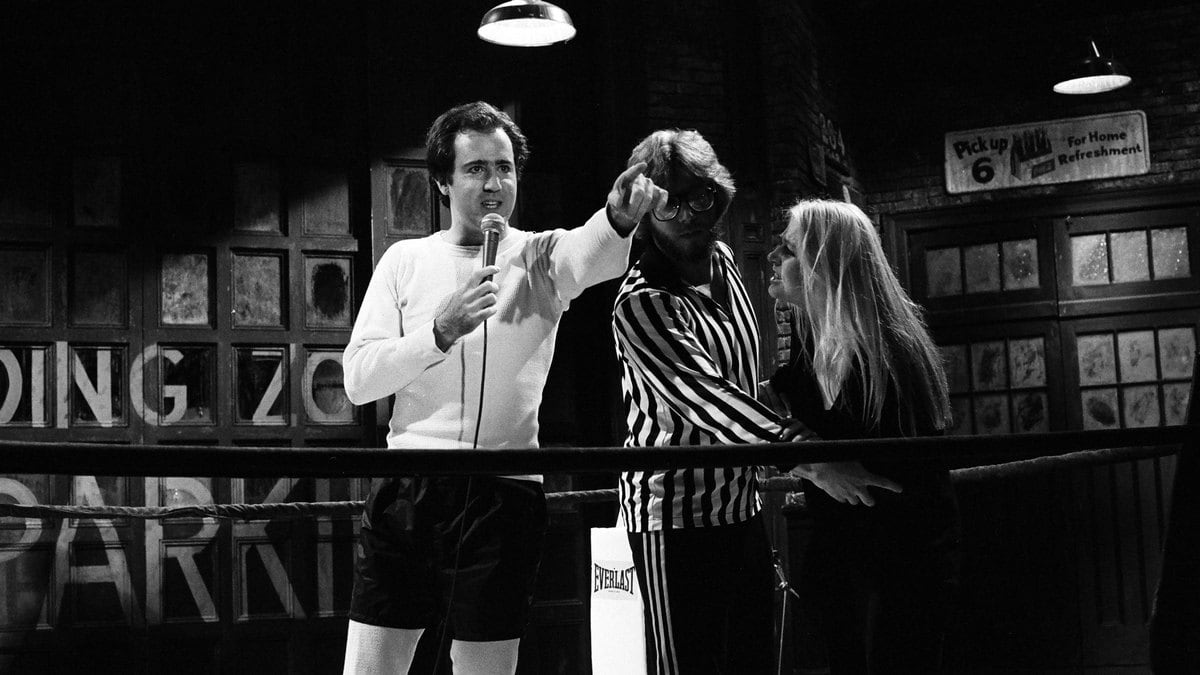In the canon of big, important American years, 1979 doesn't get as much attention as say, 1776, or 1812, or 1945. But it had some sleeper hits: Sony dropped the Walkman; Voyager 1 found Jupiter’s rings; Aaliyah was born—also, comedian Andy Kaufman wore a bathrobe on Saturday Night Live, wrestled Lacoste heiress Mimi Lambert for three straight minutes, pinned her, kicked her, and named himself the Intergender Wrestling Champion of the World.
The performance, which took place 40 years ago today, was not Kaufman’s first fight. For months, the “song and dance man” had been performing sets (he called them “concerts”) where he would invite women to wrestle. The idea was to channel old carnival wrestlers who toured town-to-town, offering $500 to any man who could pin them. Kaufman, rocking a dentist’s physique, couldn’t pull that off. Guys would crush him; he challenged girls instead. The comedian had a whole spiel to egg them on: “It takes a certain mental energy to wrestle, a certain strategy,” he says in one video at the Comedy Store. “Women, I do not think, possess this. Now, there are times when the woman does have this mental energy, for example in the kitchen, scrubbing the potatoes, washing the carrots, scrubbing the floors, raising the babies...” Usually, the rant then devolved into baby talk or shrieks.
People didn’t love it, but mostly, people didn’t know much about it, unless they’d happened into a Kaufman concert. That changed after SNL. The comic showed up in his robe, white long johns, black gym trunks, and, according to a biography, a significant amount of tape on his junk to prevent any on-air embarrassments. He gave his speech, turned down a pregnant lady, and picked Lambert, a dancer still in her leotard. They wrassled for a bit. The audience booed, while Kaufman howled reassurances (“I’M NOT CHOKING HER”) and commands (“SHUT UPPP”). After the act, Kaufman’s popularity dipped. The kayfabe of the fight—of Kaufman’s whole persona, for that matter—hadn’t registered. Audiences didn’t get that he was playing the villain, a classic wrestling trope. Departing from one convention (not hitting girls) left people fuzzy on just how many he’d abandoned. Plus, he kept screaming: “This is not a comedy routine! This is not a skit! This is real!”
The performance would achieve cult status, spawning novelty T-shirts and some real world effects on actual wrestling. But that would not become clear for a while. For months, both Kaufman and SNL received hate letters by the thousands, often from women, challenging Kaufman to a rematch. In one of the few remaining postcards, the sender wrote only her address, phone number, height (4’8”), weight (104 lbs), age (19), occupation (Junior Food Service Management major at Indiana University of Pennsylvania, part-time sautée chef), and a brief message: “I’ll beat Andy!”
But Kaufman’s biggest critic was a guy, a wrestler himself—Memphis heavyweight champ, Jerry “The King” Lawler. After Kaufman’s act aired, he kept touring around the states, showing down with over 400 women. Lawler saw him in Memphis. The fourth and final challenger that night was a tall, sturdy woman named Foxy Brown (not that one). Unlike Kaufman's early opponents, Brown stood a real chance. In the footage from that night, she grabs Kaufman’s leg, and throws him to the ground. But he recovers quickly and pins her. Lawler hated it, the idea of a man striking a woman. The irony here barely needs stating—Lawler, 66, was arrested in 2016 for domestic violence against his 27-year-old girlfriend. But his moral umbrage launched a feud that lasted until long after Kaufman died.
Lawler insisted on a rematch, offering to train Brown. When she lost again weeks later, he challenged Kaufman to a “real” fight—against him. In April of 1982, they faced off in the ring. Kaufman taunted Lawler in an unhinged Southern accent: “I’m from Hollywood! Where they make movies and TV shows! I’m not from down here in Mayn-fuss, Ten-uh-see!” As far as fighting, the comedian had some moments. At one point, as the referee held Lawler, his lavender onesie disheveled, Kaufman slapped him in the face three times. But Lawler slipped aside, and charged Kaufman for a suplex: lifting him up and slamming his back to the mat.
The melodrama peaked months later, when the two appeared on David Letterman—Kaufman in a neckbrace, Lawler dressed like an Elvis impersonator (red pants, polyester button-down, popped collar, buttons undone to his navel). Tense small talk gave way to snide insults and, in a gorgeous piece of television, Lawler smacked Kaufman out of his chair. The comedian exploded into a tantrum, hollering words the FCC doesn’t like, throwing coffee in his face, and storming off set. (The obscenities were so unkosher, NBC threatened legal action; Kaufman responded with his own lawsuit for $200 million in damages). The feud escalated from there: Kaufman put a bounty out for $5,000 to anyone who could piledrive Lawler to smithereens. There was a temporary truce, an inevitable backstabbing, and an unfortunate powder-throwing incident. The war was only cut short when Kaufman’s decade-long cough proved to be lung cancer. He died in 1984.
Like all wrestling storylines and pretty much anything Kaufman ever did, the specter of stagecraft loomed over their rivalry. But Kaufman never broke character. Neither did Lawler. After the comic died, Lawler told a reporter: “People keep asking me about Andy Kaufman’s death. I’m really the wrong person to talk to about that. I didn’t like Andy Kaufman, and Andy Kaufman didn’t like me.” Only later, when the saga appeared in the comic’s biopic, Man On The Moon (1999), did actor Jim Carrey, who went deep on Kaufman’s methods, reveal the whole thing had been a hoax.
But from this blurry unreality, a few concrete, non-joke effects emerged. Kaufman’s tussle with Lawler had been wild publicity—his NBC lawsuit made the New York Times’ front page. “If I play my cards right,” Kaufman told Rolling Stone, semi-seriously, in 1981, “I could bring network wrestling back to TV... I’m reaching people who wouldn’t otherwise watch it.” Celebrity ties pulled the Memphis scene onto the national stage, and World Wrestling Entertainment promoter Vince McMahon was watching. McMahon recruited a celebrity of his own: pop singer Cyndi Lauper. He first booked her on a WWE segment called Piper’s Pit, alongside wrestler Lou “Captain” Albano, described at length by female wrestling pioneer Lillian Ellison in her memoir, The Fabulous Moolah. On air, Albano called Lauper a “broad.” In response, she hit him with her purse—and then challenged him to a match.
This wasn’t a full-on intergender showdown; the fight would play out between two women. But it was a landmark beef. The Lauper-Albano storyline helped usher in the Rock-n-Wrestling era, a longstanding rapport between the music and wrestling worlds that was great for viewership. Months after Kaufman’s death, when McMahon brought Lauper onstage for the inaugural WrestleMania event in Madison Square Garden, the 1980s were on their way to becoming one of the largest commercial booms in wrestling history.
Another odd thing happened: real intergender matches. Real, at least, by wrestling standards. In the late 1990s, wrestling saw a spurt of intergender fights. Unlike Kaufman’s championships, these fights were not especially scandalous; and they weren’t necessarily in service of some larger feminist point either. Man-woman matches weren’t common per se, but when they happened, they were remarkable in their ordinariness. Take Chyna, for example, the first woman to fight in the Royal Rumble, who sloshed major male wrestlers on the regular. Here she is in 1999, facing off against Billy Gunn, a beefy blond in green spandex, then known as “Mr. Ass.” The two demolish each other: Ass tossing Chyna out of the ring; Chyna hitting the floor like a ragdoll; Chyna playing wounded; Ass playing concerned; Chyna slamming Ass into a set of steel stairs—all announced, by the way, by Jerry Lawler. Chyna walked away the winner.
Chyna, who became the first female Intercontinental Champion by slugging Jeff Jarrett over the head with an acoustic guitar, had peers in that realm—Madusa did man matches; Jazz was another big name. But past the ’90s, intergender wrestling faded from WWE. It found a home instead on independent programming, most recently in shows like Lucha Underground, which ended last year after four seasons, and in James Ellsworths’ Intergender Wrestling Championship, a more overtly comic contest held in Kaufman’s honor.
The reason for that disappearance is disputed. But it’s become a pertinent question. In January, when Nia Jax entered the men’s Royal Rumble, making her just the fourth woman to do so, a male wrestler superkicked her in the face. It was an uncanny and frankly, very cool move—the network’s first man-on-woman strike in years, as reporter Luis Paez-Pumar described in a piece for Deadspin that month. WWE has never specified a policy about intergender matches, but rumors swirled that they signed a contract with Mattel for a line of female wrestler dolls, which prohibited co-ed matches. A WWE spokesperson denied that any such contract existed. He claimed the network had no policy against intergender wrestling, but cited a quote from Paul Levesque, WWE executive vice president of talent, live events and creative. “I don't believe that it should be the norm,” Levesque told ESPN last year. “The women don't need a man in the ring with them to become a prime spot on the card. They don't need that to be the main event [in WWE]. They just need another woman in there that’s as great as they are."
But the question of “need” seems somewhat beside the point. The pleasure of wrestling is spectacle. Everyone knows the fights are staged. If fans had any illusions about that, they were cleared up in 1989, when the World Wrestling Federation told the New Jersey Senate the sport was just “entertainment” to avoid broadcasting taxes. The reality is not the draw. If in “real” sports, the best athletes mesmerize when they seem exempt from basic laws of human ability, wrestlers fascinate for similar reasons. Not because they transcend those laws, but because they ignore them.
Take, for example, a moment from WrestleMania 34 in April of last year. Mixed martial arts legend Ronda Rousey, who had just signed to WWE months earlier, was making her debut, teaming up with wrestler Kurt Angle to face off against their bosses: WWE execs Triple H and Stephanie McMahon. Usually in couple fights like these, the partners tag team—man v. man; woman v. woman. But about 12 minutes in, as Rousey nearly armbars McMahon into submission, Triple H reaches from outside the ropes and pulls the ref out of the ring. Rousey, eyes made up like Darth Maul, mimes fury. When Triple H, a bearded guy in a black speedo, climbs back onto the mat, she starts circling. The announcers cannot believe it. “This is not happening,” one says, “Ronda Rousey squaring off with a 14-time champion.” She advances, pummels him into the corner, and absolutely unloads. Triple H, a gargantuan man, flails like a 256-pound baby.
The clip went viral. Not because Rousey was a girlboss or whatever. The fight was plainly insane to look at, at once plausible, impossible, and eerie, like some transgression we weren’t supposed to see. As with all wrestling, it was melodrama—morality theater where avatars of human instinct play out in cartoon, tightly spandexed form. For a sport that blows up subtext and makes it legible, intergender wrestling presents a dynamic simultaneously unnerving, hilarious, and laden with baggage. But Kaufman knew that four decades ago. In his words then: “I got the brains.”






